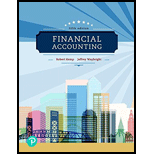
Financial Accounting (5th Edition) (What's New in Accounting)
5th Edition
ISBN: 9780134727790
Author: Robert Kemp, Jeffrey Waybright
Publisher: PEARSON
expand_more
expand_more
format_list_bulleted
Concept explainers
Question
Chapter 8, Problem 7DQ
To determine
Explain the reasons that make the repair “extraordinary” (as opposed to ordinary). State an example of an extraordinary and an ordinary repair. Describe the effect on the financial statements of recording a repair as an extraordinary repair instead of an ordinary repair.
Expert Solution & Answer
Want to see the full answer?
Check out a sample textbook solution
Students have asked these similar questions
Financial Accounting
Two investors are evaluating Anywhere e-SIM Ltd.’s stock for possiblepurchase. They agree on the expected value of D1 and also on theexpected future dividend growth rate. Further, they agree on theriskiness of the stock. However, one investor normally holds stocksfor 2 years, while the other normally holds stocks for 10 years.Is it true that they should both be willing to pay the same price forthis stock? Explain based on how stocks are valued and provide anumerical example to support your arguments.
Please need answer the accounting question
Chapter 8 Solutions
Financial Accounting (5th Edition) (What's New in Accounting)
Ch. 8 - Prob. 1DQCh. 8 - Prob. 2DQCh. 8 - Prob. 3DQCh. 8 - What is depreciation, and why is it used in...Ch. 8 - Prob. 5DQCh. 8 - Which depreciation method would be moot...Ch. 8 - Prob. 7DQCh. 8 - Prob. 8DQCh. 8 - Prob. 9DQCh. 8 - Prob. 10DQ
Ch. 8 - Prob. 1SCCh. 8 - Prob. 2SCCh. 8 - How should a capital expenditure for a long-term...Ch. 8 - Which depreciation method usually produces the...Ch. 8 - Prob. 5SCCh. 8 - Prob. 6SCCh. 8 - Prob. 7SCCh. 8 - Prob. 8SCCh. 8 - Prob. 9SCCh. 8 - Prob. 10SCCh. 8 - Prob. 11SCCh. 8 - Prob. 12SCCh. 8 - Prob. 1SECh. 8 - Long-term asset terms (Learning Objective 1) 5-10...Ch. 8 - Prob. 3SECh. 8 - Lump-sum purchase (Learning Objective 2) 5-10 min....Ch. 8 - Errors in accounting for long-term assets...Ch. 8 - Concept of depreciation (Learning Objective 3)...Ch. 8 - Depreciation methods (Learning Objective 3) 10-15...Ch. 8 - Depreciation methods (Learning Objective 3) 10-15...Ch. 8 - Prob. 9SECh. 8 - Prob. 10SECh. 8 - Prob. 11SECh. 8 - Prob. 12SECh. 8 - Prob. 13SECh. 8 - Prob. 14SECh. 8 - Prob. 15SECh. 8 - Other long term assets (Learning Objective 8) 5-10...Ch. 8 - Prob. 17SECh. 8 - Prob. 18AECh. 8 - Prob. 19AECh. 8 - Prob. 20AECh. 8 - Prob. 21AECh. 8 - Depreciation methods (Learning Objective 3) 15-20...Ch. 8 - Prob. 23AECh. 8 - Prob. 24AECh. 8 - Prob. 25AECh. 8 - Prob. 26AECh. 8 - Prob. 27AECh. 8 - Prob. 28AECh. 8 - Prob. 29AECh. 8 - Prob. 30AECh. 8 - Prob. 31AECh. 8 - Prob. 32BECh. 8 - Prob. 33BECh. 8 - Prob. 34BECh. 8 - Prob. 35BECh. 8 - Prob. 36BECh. 8 - Prob. 37BECh. 8 - Prob. 38BECh. 8 - Prob. 39BECh. 8 - Prob. 40BECh. 8 - Prob. 41BECh. 8 - Prob. 42BECh. 8 - Prob. 43BECh. 8 - Prob. 44BECh. 8 - Prob. 45BECh. 8 - Long-term asset costs and partial-year...Ch. 8 - Journalizing long-term asset transactions...Ch. 8 - Prob. 48APCh. 8 - Prob. 49APCh. 8 - Prob. 50APCh. 8 - Prob. 51APCh. 8 - Prob. 52APCh. 8 - Prob. 53BPCh. 8 - Journalizing long-term asset transactions...Ch. 8 - Prob. 55BPCh. 8 - Prob. 56BPCh. 8 - Prob. 57BPCh. 8 - Prob. 58BPCh. 8 - Prob. 59BPCh. 8 - Prob. 1CECh. 8 - Prob. 1CPCh. 8 - Continuing Financial Statement Analysis Problem...Ch. 8 - Prob. 1EIACh. 8 - Prob. 2EIACh. 8 - Financial Analysis Purpose: To help familiarize...Ch. 8 - Prob. 1IACh. 8 - Prob. 1SBACh. 8 - Written Communication A client of yours notified...
Knowledge Booster
Learn more about
Need a deep-dive on the concept behind this application? Look no further. Learn more about this topic, accounting and related others by exploring similar questions and additional content below.Similar questions
arrow_back_ios
SEE MORE QUESTIONS
arrow_forward_ios
Recommended textbooks for you
- Business/Professional Ethics Directors/Executives...AccountingISBN:9781337485913Author:BROOKSPublisher:Cengage
 Intermediate Accounting: Reporting And AnalysisAccountingISBN:9781337788281Author:James M. Wahlen, Jefferson P. Jones, Donald PagachPublisher:Cengage Learning
Intermediate Accounting: Reporting And AnalysisAccountingISBN:9781337788281Author:James M. Wahlen, Jefferson P. Jones, Donald PagachPublisher:Cengage Learning

Business/Professional Ethics Directors/Executives...
Accounting
ISBN:9781337485913
Author:BROOKS
Publisher:Cengage

Intermediate Accounting: Reporting And Analysis
Accounting
ISBN:9781337788281
Author:James M. Wahlen, Jefferson P. Jones, Donald Pagach
Publisher:Cengage Learning


